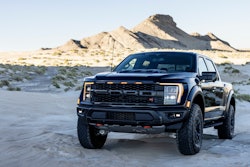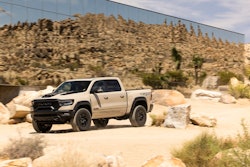
When Victor Sheppard’s 2007 Toyota Tundra reached its 1 millionth mile, almost every component of the truck was still fully functioning except for the sun visor detent on the driver’s side and the odometer, which at the 999,999-mile mark had reached its six-digit limit.
For Toyota Chief Engineer Mike Sweers, who has overseen the Tundra, Tacoma, Sequoia and 4Runner vehicle programs, the diehard truck provided an opportunity to see what made Sheppard’s Tundra so resilient.
What Sweers found helped lead to the redesign of the all-new 2022 Toyota Tundra which included innovating upon the durability of materials used, the quality of design and the reliability of the mechanics.
 2023 Toyota Tundra interiorToyota
2023 Toyota Tundra interiorToyota
In fact, the only area of the truck showing serious stress was the bed, which had been battered by the heavy equipment Sheppard, a veteran driver in the oil and gas industry, transported over the nine years he owned it. With his sights set on building the new-generation Tundra with a more durable bed, Sweers swapped mild steel for composite — a lighter, sturdier and less corrodible material. When it came time to test the new bed, Sweers got creative.
“Why don’t we do what we see in the commercials?” he asked his team. “Drop some bricks in it; maybe drop an empty toolbox.”
The Toyota team went one step further, throwing rocks, cinder blocks and even a V8 engine into the truck. With a payload capacity of up to 1,940 pounds, the composite bed survived without a dent.
Pushing for improvement
Sweers and his team made it their mission to redefine the next-generation Tundra from the ground up, starting with the chassis. Previous models featured a frame that widened in the center and narrowed toward the bed, but the new-generation Tundra embraces a linear, ladder-shaped frame. The new design gives wider support to the bed, allowing for a more even distribution of weight and a more stable ride.
Eager to find more ways to improve the Tundra’s form and function, Sweers focused on storage. He wanted to avoid the common trend of compartments-turned-trash-bins found in so many vehicles. His goal was for each storage area to be designed with purpose.
In the end, Sweers and his team completely redesigned the rear seats of the all-new Tundra. Now they feature ample storage underneath, in addition to the ability to fold for extra storage capacity.
 2023 Toyota TundraToyota
2023 Toyota TundraToyota
Sweers said he’s remained grounded in the same philosophy that has driven Toyota production for the past 60 years.
“We have to make sure that wherever you take your truck, you can get back,” he said.
With a community of Tundra drivers across the globe, this responsibility carries extra weight.
“If you’re in the Outback of Australia, you might not see another person for a week,” Sweers said.
Tough demands placed on Tundra has Sweers pushing for more reliable parts.
The new-generation Tundra features a 1¾-inch drive chain — one-quarter wider than all previous models.
“When you increase the width of the chain, your planetary gear, your shafts, everything else has to be beefed up to go along with that,” Sweers explained.
The result is a beefed up 583 pound-feet of torque and an increased towing capacity of 12,000 lbs., a 17.6% increase over the previous generation.
Tundra has amassed a following from those who remain impressed with its strength and reliability.
“You can see people with stickers that say the 300,000-mile club, the 400,000-mile club and the 500,000-mile club,” Sweers said.
And of course, Sheppard has inducted his Tundra into the coveted million-mile club.











